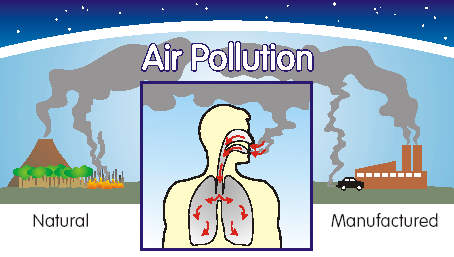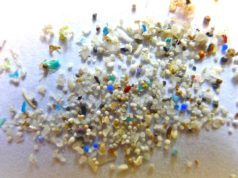We breathe from the moment we are born until the moment we die. It is a vital and constant need, not only for us but for all life on Earth. Poor air quality affects us all: it harms our health and the health of the environment, which leads to economic losses. But what does the air we breathe consist of and where do the various air pollutants come from?
The atmosphere is the gaseous mass that surrounds our planet and has been classified into layers with varying densities of gases. The thinnest and lowest (ground-level) layer is known as the troposphere. This is where plants and animals live and where our weather patterns occur. Its altitude reaches about 7 kilometres high at the poles and 17 kilometres at the equator.
Like the rest of the atmosphere, the troposphere is dynamic. Depending on the altitude, the air has a different density and a different chemical composition. The air moves around the globe constantly, crossing oceans as well as vast areas of land. Winds can carry small organisms, including bacteria, viruses, seeds and invasive species to new locations.
What we call air consists of…
Dry air is made up of about 78 % nitrogen, 21 % oxygen and 1 % argon. There is also water vapour in the air, making up between 0.1 % and 4 % of the troposphere. Warmer air usually contains more water vapour than colder air.
The air also contains very small amounts of other gases, known as trace gases, including carbon dioxide and methane. The concentrations of such minor gases in the atmosphere are generally measured in parts per million (ppm). For example, the concentrations of carbon dioxide, one of the most prominent and abundant trace gases in the atmosphere, were estimated to be around 391 ppm, or 0.0391 %, in 2011 (EEA indicator on atmospheric concentrations).
In addition, there are thousands of other gases and particles (including soot and metals) released into the atmosphere from both natural and man-made sources.
The composition of the air in the troposphere changes all the time. Some of the substances in the air are highly reactive; in other words, they have a higher propensity to interact with other substances to form new ones. When some of these substances react with others, they can form ‘secondary’ pollutants harmful to our health and the environment. Heat – including from the sun – is usually a catalyst facilitating or triggering chemical reaction processes.
What we call air pollution..
Not all substances in the air are considered pollutants. In general, air pollution is defined as the existence of certain pollutants in the atmosphere at levels that adversely affect human health, the environment, and our cultural heritage (buildings, monuments and materials). In the context of legislation, only the pollution from man-made sources is considered, although pollution might be defined more broadly in other contexts.
Not all air pollutants come from man-made sources. Many natural phenomena, including volcanic eruptions, forest fires, and sand storms release air pollutants into the atmosphere. Dust particles can travel quite far depending on winds and clouds. Regardless of whether they are man-made or natural, once these substances are in the atmosphere, they can take part in chemical reactions and contribute to air pollution. Clear skies and high visibility are not necessarily signs of clean air.

Despite significant improvements in recent decades, air pollution in Europe continues to harm our health and the environment. In particular, pollution from particulate matter and pollution from ozone pose serious health risks to European citizens, affecting quality of life and reducing life expectancy. But different pollutants have different sources and impacts. It is worth taking a closer look at the main pollutants.
When tiny particles float in the air..
Particulate matter (PM) is the air pollutant that causes the greatest harm to human health in Europe. Think of PM as particles so light that they can float in the air. Some of these particles are so small (one thirtieth to one fifth of the diameter of a human hair) that not only do they penetrate deep in our lungs, they also pass into our bloodstream, just like oxygen.
Some particles are emitted directly into the atmosphere. Others come about as a result of chemical reactions involving precursor gases, namely sulphur dioxide, nitrogen oxides, ammonia, and volatile organic compounds.
These particles can be composed of various chemical components, and their impact on our health and the environment depends on their composition. Some heavy metals, such as arsenic, cadmium, mercury and nickel, can also be found in particulate matter.
A recent study by the World Health Organization (WHO) shows that fine particle pollution (PM2.5 i.e. particulate matter no greater than 2.5 microns in diameter) might be a greater health concern than previously estimated.
According to the WHO’s “Review of evidence on health aspects of air pollution”, long-term exposure to fine particles can trigger atherosclerosis, adverse birth outcomes, and childhood respiratory diseases. The study also suggests a possible link with neurodevelopment, cognitive function and diabetes, and strengthens the causal link between PM2.5 and cardiovascular and respiratory deaths.


Baby was born earlier due to air pollution, earthtimes.org
Depending on their chemical composition, particles can also affect global climate by either heating or cooling the planet. For example, black carbon, one of the common components of soot found mostly in fine particles (smaller than 2.5 microns in diameter), results from the incomplete combustion of fuels — both fossil fuels and wood burning. In urban areas, black carbon emissions are mostly caused by to road transport, diesel engines in particular. Besides its health impacts, black carbon in particulate matter contributes to climate change by absorbing the sun’s heat and warming the atmosphere.
Ozone: when three atoms of oxygen bind together
Ozone is a special and highly reactive form of oxygen, consisting of three atoms of oxygen. In the stratosphere — one of the upper layers of the atmosphere — ozone protects us from the Sun’s dangerous ultra-violet radiation. But in the lowest layer of the atmosphere — the troposphere — ozone is in fact an important pollutant affecting public health and nature.
Ground-level ozone is formed as a result of complex chemical reactions between precursor gases such as nitrogen oxides and non-methane volatile organic compounds. Methane and carbon monoxide also play a role in its formation.
Ozone is powerful and aggressive. High levels of ozone corrode materials, buildings and living tissue. It reduces plants’ ability to conduct photosynthesis, and hinders their uptake of carbon dioxide. It also impairs plant reproduction and growth, resulting in lower crop yields and reduced forest growth. In the human body, it causes inflammation in the lungs and the bronchia.
Once exposed to ozone, our bodies try to prevent it from entering our lungs. This reflex reduces the amount of oxygen we inhale. Inhaling less oxygen makes our hearts work harder. So for people already suffering from cardiovascular diseases or respiratory diseases like asthma, high-ozone episodes can be debilitating and even fatal.
What else is in the mix
Ozone and PM are not the only air pollutants of concern in Europe. Our cars, lorries, energy plants and other industrial facilities all need energy. Almost all vehicles and facilities use some form of fuel and burn it to obtain energy.
Fuel combustion usually changes the form of many substances, including nitrogen — the most abundant gas in our atmosphere. When nitrogen reacts with oxygen, nitrogen oxides form in the air (including nitrogen dioxide NO2). When nitrogen reacts with hydrogen atoms, it creates ammonia (NH3), which is another air pollutant with severe adverse effects on human health and nature.
In fact, combustion processes release a variety of other air pollutants, ranging from sulphur dioxide and benzene to carbon monoxide and heavy metals. Some of these pollutants have short-term effects on human health. Others, including some heavy metals and persistent organic pollutants, accumulate in the environment. This allows them to get into our food chain and ultimately end up on our plates.
Other pollutants, such as benzene, can damage cells’ genetic material and cause cancer in the event of long-term exposure. As benzene is used as an additive to petrol, around 80 % of benzene released into the atmosphere in Europe comes from the combustion of fuels used by vehicles.
Another known cancer-causing pollutant, benzo(a)pyrene (BaP), is released mainly from the burning of wood or coal in residential stoves. Car exhaust fumes, especially from diesel vehicles, is another source of BaP. In addition to causing cancer, BaP can also irritate the eyes, nose, throat and bronchial tubes. BaP is usually found in fine particles.
Measuring the impacts on human health
Although air pollution affects everyone, it does not affect everyone to the same extent and in the same way. More people are exposed to air pollution in urban areas because of the higher population densities there. Some groups are more vulnerable, including those suffering from cardiovascular and respiratory diseases, people with reactive airways and airway allergies, the elderly, and infants.
‘Air pollution affects everyone in developed and developing countries alike,’ says Marie-Eve Héroux from the World Health Organization’s Regional Office for Europe. ‘Even in Europe, there is still a high proportion of the population that is exposed to levels exceeding our recommendations on air quality guidelines.’
It is not easy to estimate the full extent of the damage to our health and the environment caused by air pollution. However, there are many studies based various sectors or pollution sources.
According to the Aphekom project co-funded by the European Commission, air pollution in Europe leads to a reduction in life expectancy of around 8.6 months per person.
Some economic models can be used to estimate the costs of air pollution. These models typically contain the health costs caused by air pollution (loss of productivity, additional medical costs, etc.), as well as costs arising from lower crop yields and damage to certain materials. However, such models do not include all the costs to society caused by air pollution.
But even with their limitations, such cost estimates give an indication of the magnitude of the damage. Nearly 10 000 industrial facilities across Europe report the amounts of various pollutants they emit to the atmosphere to the European Pollutant Releash and Transfer Register (E-PRTR). Based on these publicly available data, the EEA estimated that air pollution from the 10,000 largest polluting facilities in Europe cost Europeans between EUR102 and EUR169 billion in 2009. Importantly, just 191 facilities were found to be responsible for half of the total damage cost.
There are also studies estimating the possible gains that could be obtained by improving air quality. For example, the Aphekom study predicts that reducing annual average levels of PM2.5 to World Health Organisation guideline levels would result in concrete gains in life expectancy. Achieving just this target is expected to result in possible gains ranging from 22 months on average per person in Bucharest, and 19 months in Budapest, to 2 months in Malaga, and less than half a month in Dublin.


Pollution without borders
Although some areas and countries might experience its impacts on public health or the environment more severely than others, air pollution is a global problem.
Global winds mean that air pollutants move around the world. A part of the air pollutants and their precursors found in Europe are emitted in Asia and North America. Similarly, a part of the pollutants released into the air in Europe are transported to other regions and continents.
The same is also true on a smaller scale. The air quality in urban areas is generally affected by the air quality in the surrounding rural areas and vice versa.
‘We breathe all the time and are exposed to air pollution — whether indoors or outdoors,’ says Erik Lebret from the National Institute for Public Health and the Environment (RIVM) in the Netherlands. ‘Everywhere we go we are breathing air, which is contaminated with a whole range of pollutants at levels where you can sometimes expect adverse health effects. Unfortunately, there is no place where we can breathe only clean air.
Part from “Every breath we take”, on:
http://www.eea.europa.eu/signals/signals-2013/articles/every-breath-we-take



















